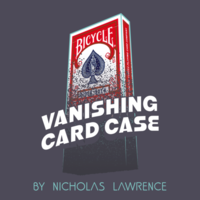Swap Wallet (Himber Style) Plastic by Mr. Magic
| List price: | |
| Price: | $5.41 |
| You save: | $0.28 (4%) |
Out of stock.
This product has been discontinued. If you are the manufacturer of this item please contact Penguin to help us re-stock.
A clever utility wallet for magicians to vanish, produce or exchange playing cards, business cards, photographs, paper money and more. It seems ordinary, but it is sneaky and can do wonders for you!
Mr. Magic Swap Wallet is an economical Himber wallet. Perfect for packet tricks and bill changes!!!
Includes:
- Easy-to-use wallet
- Written instructions
Have a question about this product?
ASK HERE
ASK HERE
Featured Magic Tricks
Customer Reviews (showing 1 - of 3)
5 star 33%
4 star 33%
3 star 33%
2 star 0%
1 star 0%
4 star 33%
3 star 33%
2 star 0%
1 star 0%

 Interesting potential, if it suits your needs...
Report this review
Interesting potential, if it suits your needs...
Report this review
Verified buyer
Pro Privacy ON
(login to see reviewer names)
on June 12th, 2021
(This review is for Swap Wallet (Himber Style) Plastic by Mr. Magic)
The product description needs more detail. I don't think I'm giving away any secrets here, as it is
already advertised as a swap wallet.
More info: it is NOT a z-fold type of wallet. Instead, it is built like the old Jacob's Ladder wooden toys - it's two pieces held together by bands that allow one side to flip over to the other side. That's kind of a fun effect in itself. - you can close it from left to right, then open it from left to right and repeat. You can have it "walk" across a table by repeatedly opening and closing it from the same side.
(You can see the outer bands in the picture, above and below the pocket on the right side. The inner band is actually the window pocket on the left side.)
The main advantage of this style is that there isn't a back end of the Z to have to protect. You don't have to worry about it accidentally opening up from the back. There simply isn't a back end to have to keep closed.
You can't give it to the spectator to examine, but you can casually wave it around and show inside and outside while holding it at the corner.
It basically looks like a cheap checkbook cover, and you could probably explain it that way.
It is NOT ideal for switching/hiding anything thick, such as hiding a packet of 5 gimmicked cards and replacing them with a packet of 4 clean cards. The thickness will cause the two halves to separate too much, making a visible gap between the two halves when you close it. Use something else for that sort of thing.
It's best for billet work or a single playing card or a dollar bill. You can use either of the two pockets to do the vanish/switch.
You can also use the space behind the window pocket as a pass-through to the "other side" of the wallet, though the item will not be in a pocket when you open the wallet from the other end. That might be useful in reverse. For example, if you lay a playing card on top of the window pocket and close the wallet over it, when you open the other side the card will be in the extra compartment behind the window pocket.
One other caution is that you really only want to use the area in the pockets or behind the window pockets. If you see the bands above and below the non-window pocket in the picture, you need to keep the area where the bands are clear so that the wallet can close and open properly.
All in all, the Jacob's Ladder design is an interesting approach for a swap wallet. It's not all that sturdy in construction and the design has its limitations. But it's an inexpensive tool for billet switches that might also have other creative uses.
2 of 2 magicians found this helpful.
More info: it is NOT a z-fold type of wallet. Instead, it is built like the old Jacob's Ladder wooden toys - it's two pieces held together by bands that allow one side to flip over to the other side. That's kind of a fun effect in itself. - you can close it from left to right, then open it from left to right and repeat. You can have it "walk" across a table by repeatedly opening and closing it from the same side.
(You can see the outer bands in the picture, above and below the pocket on the right side. The inner band is actually the window pocket on the left side.)
The main advantage of this style is that there isn't a back end of the Z to have to protect. You don't have to worry about it accidentally opening up from the back. There simply isn't a back end to have to keep closed.
You can't give it to the spectator to examine, but you can casually wave it around and show inside and outside while holding it at the corner.
It basically looks like a cheap checkbook cover, and you could probably explain it that way.
It is NOT ideal for switching/hiding anything thick, such as hiding a packet of 5 gimmicked cards and replacing them with a packet of 4 clean cards. The thickness will cause the two halves to separate too much, making a visible gap between the two halves when you close it. Use something else for that sort of thing.
It's best for billet work or a single playing card or a dollar bill. You can use either of the two pockets to do the vanish/switch.
You can also use the space behind the window pocket as a pass-through to the "other side" of the wallet, though the item will not be in a pocket when you open the wallet from the other end. That might be useful in reverse. For example, if you lay a playing card on top of the window pocket and close the wallet over it, when you open the other side the card will be in the extra compartment behind the window pocket.
One other caution is that you really only want to use the area in the pockets or behind the window pockets. If you see the bands above and below the non-window pocket in the picture, you need to keep the area where the bands are clear so that the wallet can close and open properly.
All in all, the Jacob's Ladder design is an interesting approach for a swap wallet. It's not all that sturdy in construction and the design has its limitations. But it's an inexpensive tool for billet switches that might also have other creative uses.
Did this review help you?
Do you want to respond to this review?

 Swap wallet by Mr. Magic
Report this review
Swap wallet by Mr. Magic
Report this review
Verified buyer
Pro Privacy ON
(login to see reviewer names)
on August 14th, 2023
(This review is for Swap Wallet (Himber Style) Plastic by Mr. Magic)
Good little utility device. Even though it's plastic it works well. Does what a swap wallet should.
Did this review help you?
Do you want to respond to this review?

 Not what I was expecting
Report this review
Not what I was expecting
Report this review
Verified buyer
Pro Privacy ON
(login to see reviewer names)
on June 12th, 2018
(This review is for Swap Wallet (Himber Style) Plastic by Mr. Magic)
Not what I was expecting, to be honest, but for the price I can't complain.
0 of 1 magicians found this helpful.
Did this review help you?
Do you want to respond to this review?
OPEN BOX
$29.06 (27% OFF)
56
Bestsellers
See all bestsellers
COOL BOX
12% now claimed
0
3
:
4
8
:
1
2
remaining

Act Builder beta








































